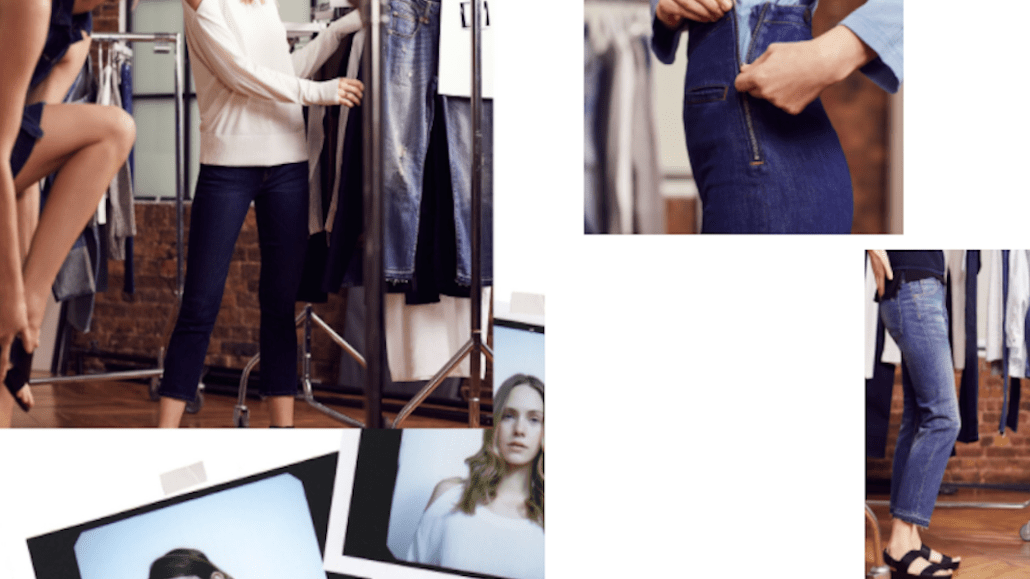
The Outnet’s Facebook messenger chatbot starts off predictably. The tool first asks if you’re looking for wardrobe ideas or customer service help. If you’re looking for ideas, it then asks if you’re shopping for a certain event or category, like vacation outfits or desk-to-dinner, or for more general style inspiration. (If you’re in need of customer service, you’ll be connected to a real person).
Depending on how you answer changes the course of the conversation. If you’re indeed looking for vacation outfits, the prompt will take you out of the chat and to The Outnet’s vacation trends shop on its site. But those shopping with less direction are introduced to The Outnet’s “stylish friends”: editors and influencers who have worked with The Outnet on one of its video series. The bot takes users through a series of more whimsical prompts that range from standard (“Is your style more ‘laid-back L.A.’ or ‘East Coast elegance’?”) to borderline absurd (“Would you ever leave the house without underwear?”).
Each response conjures up a content hook featuring an influencer, like a 15-second video clip that auto-plays in the chat or an excerpt from a Q&A, followed by a prompt to shop a featured brand or category.
“This is a new channel for us to broadcast the content that lives on our site and help customers navigate our assortment,” said said Andres Sosa, evp of sales, marketing and creative at The Outnet.

With the bot, The Outnet wants to make the most of both its in-house content and its Facebook followers, while avoiding expensive paid posts and promoted videos. The competitive landscape for e-commerce marketplaces has made the cost of customer acquisition skyrocket, and as social media marketing shifts from organic to paid reach, pulling in customers through editorial POV-derived inspiration is critical in controlling marketing spend. Bots aren’t free — The Outnet worked with an external partner to build its version over the course of eight months — but they’re easier to maintain than constant promotions. They also act as data vehicles.
Ad position: web_incontent_pos1
“The goal is to trace customer behavior from social media. All of our social channels have sales targets,” said Sosa. “Facebook, for us, has been very profitable. Instagram, we’re getting there. It’s about connecting the dots and making sure every piece of content she sees is engaging, and also has a commercial element attached.”
Chatbots, which have fared better for the beauty industry than fashion, are still in early phases of adoption as brands try to figure out what approach works best. In January, Facebook Messenger disabled its M platform, a virtual personal assistant that powered customer service inquiries with AI. So brands are warming up to content-driven chatbots, as companies like Tommy Hilfiger and Burberry ping those who subscribe with news, like the start of a live-streamed fashion show or new product arrivals. For The Outnet, the first thing it asks those who visit it on Messenger is whether or not they’d like regular style news delivered through the bot.
“It’s not as easy as just ‘insert chatbot here.’ Chatbots were initially positioned to retailers and brands as a magic bullet, where all you needed was a bot,” said Maya Mikhailov, the CMO of mobile commerce platform GPShopper. “As retailers think about what they’re going to do with bots, they need to remember it needs to be usable and scalable. Bots aren’t a bandaid solution for customer service solutions.”
With the chatbot, The Outnet plans to track the type of content that drives customers back to the site most frequently. With evergreen content backdrops, it can swap out the shoppable elements, like brands and trends, according to what’s popular or driving the most traffic. The editorial team works with the merchandising team to plan what products will be promoted through the bot, which rolled out in February.
It also put together a 10,000-person panel of “Outnet Insiders,” sourced from a customer pool, to find out what type of articles and videos from The Outnet they would be interested in. From that panel, The Outnet found that its customers care about influencer style, which inspired its three recurring series: “Dropped Pins,” a video series around how to dress for different cities; “Speed Dial,” a video interview series; and “Cheat the Week,” a written week-in-the-life Q&A.
Ad position: web_incontent_pos2
The bot is also a guinea pig for YNAP to see how much stickiness the channel has as a social content vehicle. YNAP, which opened a 500-person tech hub last year, is testing the different ways AI and virtual commerce can make the customer journey easier, and keep customers returning for a more personalized experience.
“Mobile is the future of shopping, so everything we do supports that belief,” said Frederico Marchetti, YNAP’s CEO, during the announcement of the tech hub. “I don’t believe in the super automation of everything, but AI can understand customers on a personal level, and we plan to take advantage of that and understand its potential first.”
More in Marketing

In the marketing world, anime is following in the footsteps of gaming
As marketers look to take advantage of anime’s entry into the zeitgeist, they might be wise to observe the parallels between the evolution of anime as a marketing channel and the ways brands have learned to better leverage gaming in recent years.

With the introduction of video ads and e-commerce, Roblox looks to attain platform status
Roblox is expanding into more areas than just ads in 2024. Much like platforms such as Amazon and Facebook have transcended their origins to evolve from their origins as online marketplaces and social media channels, Roblox is in the midst of a transformation into a platform for all elements of users’ virtual lives.

PepsiCo wants to remain a ‘driver of culture’ as it turns to influencers and activations amid rebrand
The soda-maker says it can translate cultural relevance into sales volume.
Ad position: web_bfu




